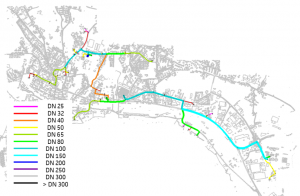The urban heating network extension or planning process usually begins with an analysis of the potential of heat need. Follows the route of the network generally to rule along main streets. Then comes the concept of heat production which will cover the needs (with a comfortable overdesign factor), to finish on optimization at all and in particular costs.
This process (almost) – Centennial is still very fragmented, mixing calculation tools very various, management of "semi" data, decisions to the wet finger based on experience. CEL in addition to strangers such as: what proportion of households will connect to the network? What proportion of buildings will be renovated (and will therefore see their need of heat declined drastically) the next years? The application of heat will be always strong enough along the network? Because of this complexity, operators of heating network is limited to city centres, if possible close to buildings energy efficient, to ensure their profitability. While several projects have proved their profitability to connect neighborhoods of low-energy and passive houses.
The 3D city models represent a new generation of tools for planning, more automatic and integrated than the traditional method, able to find optimum solutions to the problems.
City CityGML models include in particular models of buildings, land and underground, transport (if not importable from openstreetmap) and soon the models of urban networks (Thematic Module UtilityNetwork coming in the new version of CityGML 3.0). 3D allows to precisely model the path of the network in the basement, taking into account the other underground networks as well as the local geology.
By combining thermal needs geo-localized calculated precisely for each building, a digitized street map and a few parameters cost and constraints of felt (for a slice along a street, the route of a private field or a cellar etc.), and by turning the whole with a graph theory algorithm coupled with a software professional sizing and simulation of heat networks , it will be possible to generate automatically a trace and dimensioning of heating network optimized. From there, many variations are possible: simulation of different rates of connection, of different scenarios for building renovation, intensification in the medium term, criteria for connection etc… the possibilities are endless.
Prerequisite: 3D city model LoD1/LoD2, model field, data network if existing (plan, temperature etc…)
Initiatives & contacts
SIMSTADT, urban energy simulation platform
- Partners: HFT Stuttgart, GEF, MOSS
- Contacts: New Roman, Eric Duffy (HFT Stuttgart).
Platform AixLib (Germany)
- Developer: RWTH Aachen – E Research center
- Contact: Moritz Lauster
